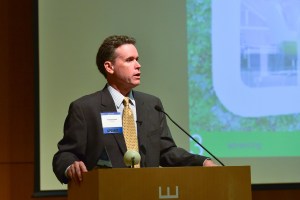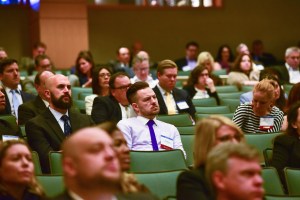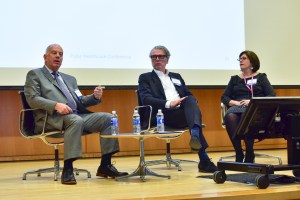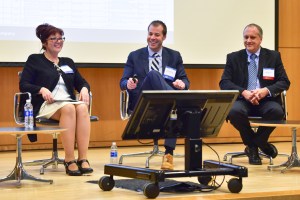Will Google Take Over the Medical Industry? Big Questions at CO’s Healthcare Conference
By Liam La Guerre and Rheaa Rao November 11, 2016 2:00 pm
reprints
Could Apple or Google soon start making tech for your health needs? Or (stranger still) become your healthcare provider?
That was among the big questions asked at this week’s seventh annual Pulse Healthcare Conference presented by the Commercial Observer.
“There are so many more people entering the system,” Andrew Quirk, a senior vice president at Skanska, told a room with 200 people in his keynote address. “It’s an absolute huge driving force into the ways we’re designing, constructing and operating the facilities that we have today.”

Quirk was highlighting predictions made by Dr. Peter Diamandis, a physician and co-founder of healthcare data organization Human Longevity, at the event on Thursday morning at the CUNY Graduate Center at 365 Fifth Avenue.
This speech was followed by a panel on how patient satisfaction and space efficiency are dictating today’s healthcare projects, which was moderated by Ted Shaw, an associate principal of Perkins + Will.
Lucy Xenophon, the chief transformation officer of Mount Sinai St. Luke’s, said that to improve patients’ experience, they must also keep the staff of doctors and nurses in mind. She explained that they were able to improve their performance after optimizing their workspace design, therefore cutting down on wasted time for the nursing staff and allowing them to get to patients faster—increasing patient satisfaction.
“It’s not only about can we have valet parking or a pretty room,” she said. “It’s about whether our staff is working well, whether they’re engaged.”

Photo: Sean Zanni/PMC
The ensuing panel, which was about the future of hospitals, was moderated by Gina Kish, a principal architect at Stantec. Panelist Robert Lanzarone, a project executive of Turner Construction, made calls for hospitals to cater to young doctors, just as how they cater to younger patients with more technological enhancements. And Joan Saba, a partner at design firm NBBJ, spoke about the use of virtual reality to get more design feedback and enhance hospital workstations for staffers.
Michael Zetlin, a founding partner of law firm Zetlin & De Chiara, introduced the next panel on strategies for growth in hospitals. In that part of the conference, Northwell Health Assistant Vice President Donna Ryan-Rose made the case that today’s millennial generation has more data on its fingertips and is less concerned about location of their facilities—since they can just Google or Yelp a doctor or urgent care and read reviews.

“Baby Boomers wanted things that were located where they could find them easily. I’ve been by it, I’ve driven past it; I know where it is,” Ryan-Rose said. “The millennials, because of their access to data, they don’t really care where it is. They just go on [Google] Maps and it’ll drive you directly to where the facilities are that you are looking for.”
To cap the event around midday, there was a panel discussion about the tools to minimize disruption of operations. This was moderated by Mary Frazier, a principal at architecture and engineering firm Ewing Cole, and once again the panel got on the topic of virtual reality.
A major problem in the industry has been recording as-built blueprints of hospitals after construction or maintenance work; virtual reality could be helpful for hospitals to store this data.

“The problem is that when we are done with the construction we can guarantee that we are giving you back an accurate as-built model, but what happens is throughout the years of maintenance and operation it’s possible that things get added and things get moved,” said Peter Mulcaey, a vice president at Gilbane Building Company. “One of the greatest challenges for a hospital now is that they need to make sure they have programs so whenever the they do maintenance, somebody goes in to maintain the [virtual] model itself and update with the accurate information.”



